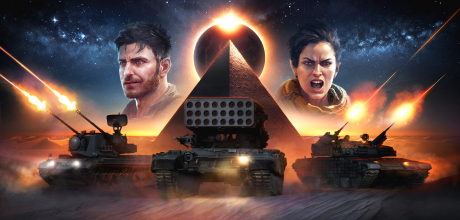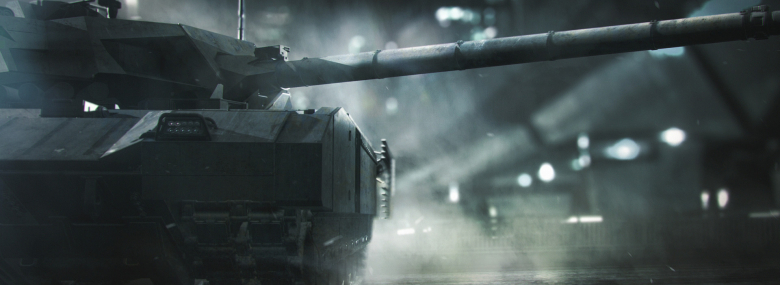
Commanders!
Yes, that’s a playable TOS and yes, it’s the top prize of the Eclipse Battle Path. Now that we hopefully have your attention, let’s talk a bit about the vehicle series and where that 30mm gun on it came from because that’s no ordinary rocket launcher. Without further ado, here’s the history of TOS-1M Buratino.
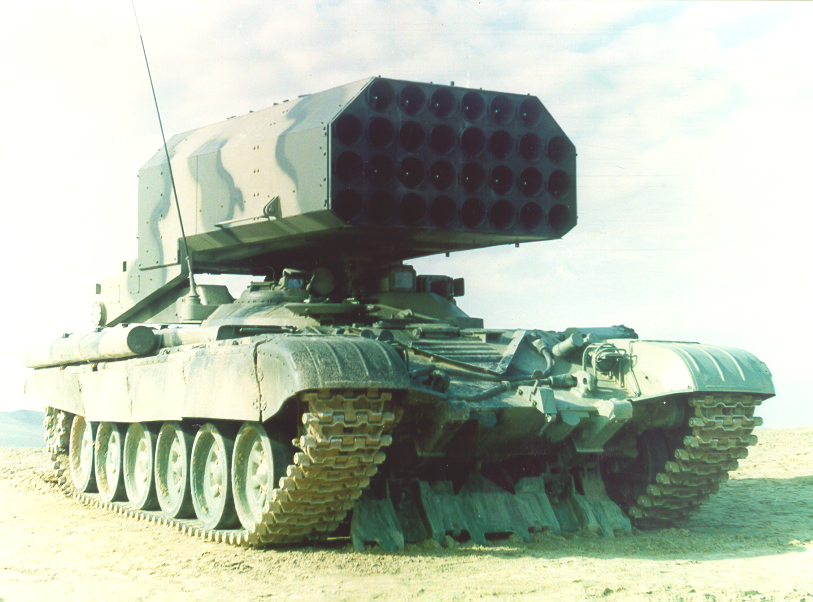
TOS-1 Buratino
Let’s start with the name TOS, which stands for “heavy flamethrower system” in Russian. This is due to the fact that the Russians consider thermobaric launchers and weaponry in general to be an evolution of flamethrowers much like the Shmel hand-held thermobaric rocket launcher that was developed during the war in Afghanistan.
The history behind the TOS series goes further back though, all the way to the late 1960s. In 1969, V.K. Pikalov became the commander of Soviet chemical troops and what he really wanted was to have a flamethrower artillery system amongst his arms. In the early 1970s, he visited the Tula design bureau responsible for the development of the famous Grad rocket launcher and ordered the development of such a system.
The initial project was ready in the August of 1972 and consisted of a T-72-based rocket launcher with a three-kilometer range, an ammunition truck and new incendiary unguided rockets. The next few years were spent developing incendiary rocket mixtures until the design was more or less realistic and was approved for further, more detailed development in 1976. That’s where the name “Buratino” appeared first – it was a designation for the entire project. The word itself comes from a popular Russian children tale by L.N. Tolstoy, in which Buratino is a wooden boy – essentially a re-telling of the Pinocchio tale. Some sources claim the name was chosen because the protruding rocket fuse resembled Buratino’s nose.
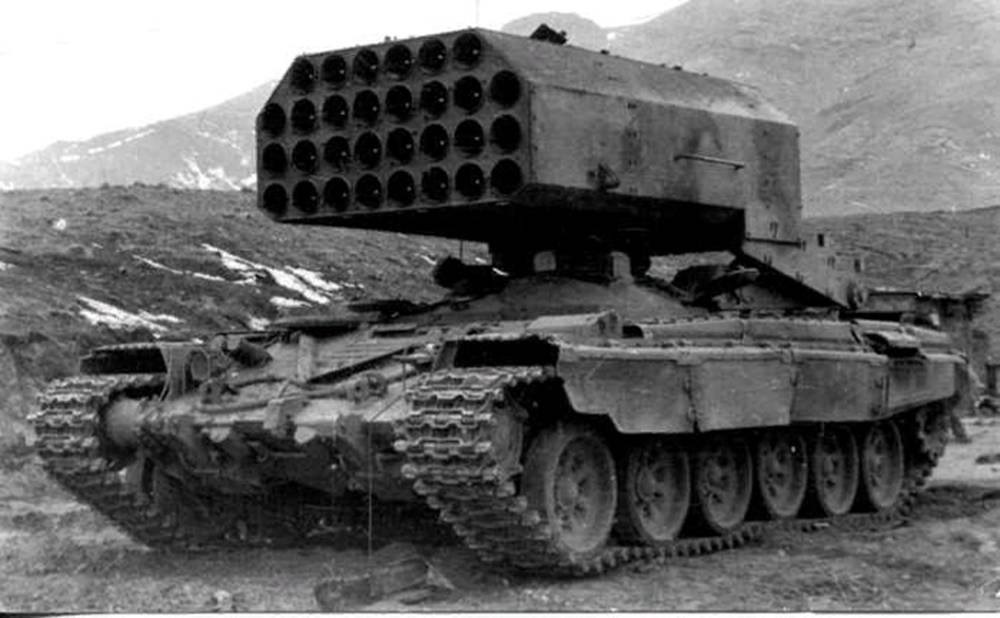
TOS-1 Buratino in Afghanistan
The first two prototypes appeared in 1978 and 1979. These were T-72-based and were built in Omsk. The vehicle passed its trials successfully but wasn’t accepted in service due to its insufficient firepower. The development of a new rocket explosives was therefore launched, resulting in new, thermobaric warheads.
A few words about thermobarics. Unlike a conventional bomb that uses solid explosives with an oxidizer, a thermobaric bomb is filled with fuel that it spreads and ignites in the form of a cloud of aerosol. In other words, the explosion is oxidized by the air, not by a separate oxidizer. Its burning cloud along with pressure changes caused by the explosions deal tremendous damage to any unprotected target, causing severe burns and organ ruptures at considerable distances. This type of weapon is incredibly effective against structures such as buildings, bunkers, trenches and caves, hence its use in Afghanistan (by both the Soviets and the Americans two decades later). However, this weapon type also has significant downsides as it cannot be used in poor weather, high altitudes, under water and the blast wave doesn’t do much against hardened targets such as sealed bunkers.

TOS-1 Buratino in Afghanistan
Back to our short history part. The year was 1988 and the war in Afghanistan was not going well for the Soviets. While it could not turn the tides of war in Soviet favor, the performance of the two prototype Buratino rocket launchers in Afghanistan was highly successful. It quickly became possibly the most feared Soviet weapon system due to the fact that its 220mm thermobaric rockets were utterly and completely devastating. The Buratino was a relic of the times when the urban fighting success wasn’t measured by rooms cleared but by city blocks leveled.
The Buratino was officially accepted in service in 1995, although it wasn’t until 1999 when it was first officially shown in public during the Second Chechen War. It’s worth noting that it isn’t the artillery branch that’s operating the TOS vehicles – these systems are operated by Russia’s chemical (NBC protection) troops, likely a throwback to how the entire program started.
Two years later, in 2001, a more famous version of the Buratino appeared – this was the TOS-1A Solntsepyok ("sun’s scorch”). Unlike the Buratino, the TOS-1A was officially accepted in service (in 2003), built in significant numbers and was exported as well. But the TOS-1A is a different machine – let us get back to the Buratino and the Soviet experience in its use.
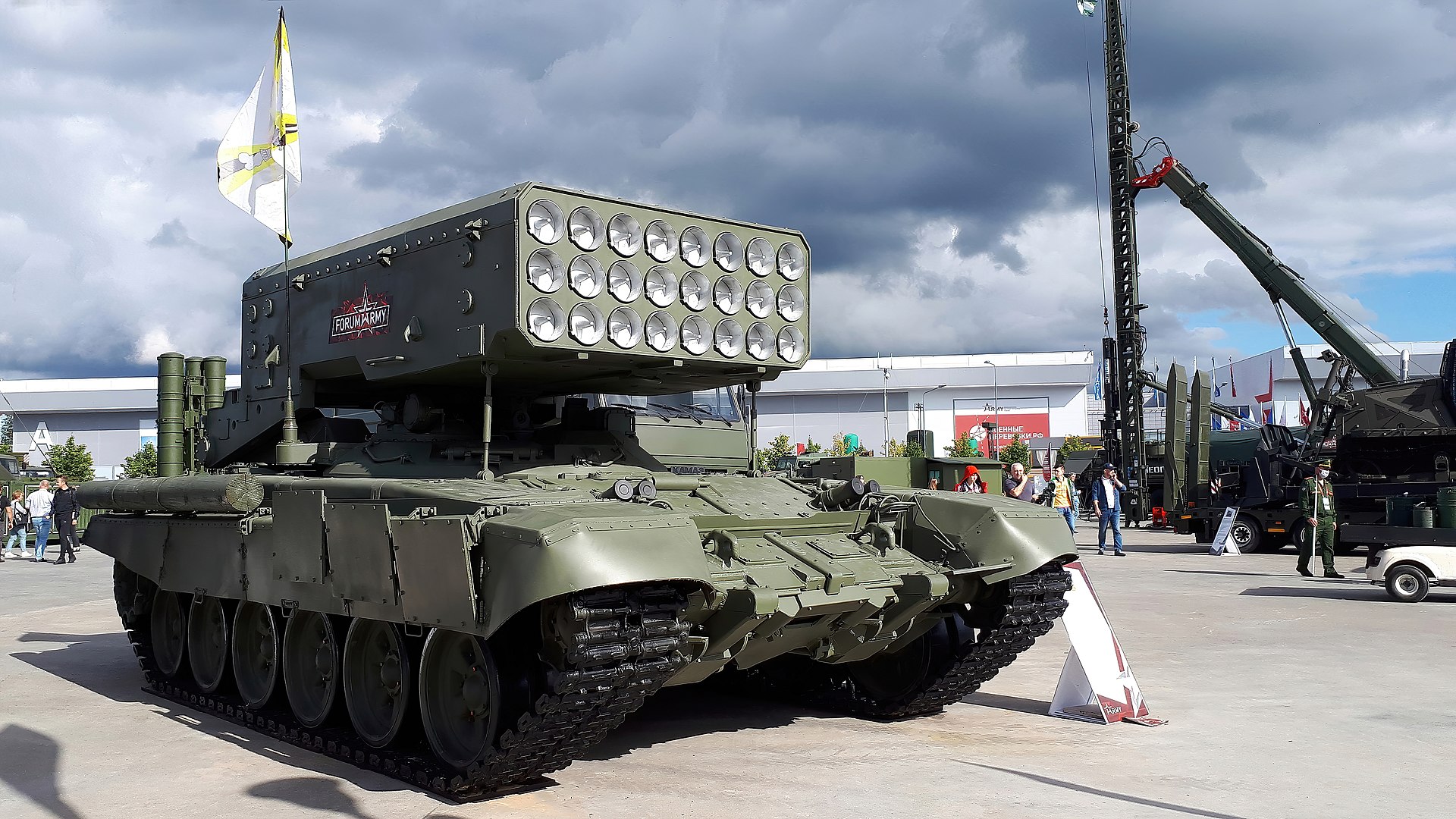
TOS-1A, 2020
Even during the very first engagements, it was clear that due to its relatively low range of three kilometers or so, the Buratino had a problem as, unlike the other self-propelled artillery pieces in Soviet and later Russian service, it sometimes found itself within the range of enemy retaliation. Additionally, when reloading or deploying to fire, the Buratino was completely defenseless.
As a stopgap measure, the rare Buratinos deployed in Afghanistan had to be escorted by vehicles capable of engaging soft targets at close ranges (or in elevated positions) such as the BMP-2. This, of course, wasn’t ideal and it was deemed necessary for the vehicle to be able to defend itself on its own and by that time, the specialized BMO-T wasn’t developed yet (and wouldn’t have enough firepower even if it had been available at the time).
To address these issues, a project called TOS-1M was developed in 1997 in Omsk – evolution-wise, it falls right between the TOS-1 and the TOS-1A. It’s neither really, but it’s a version of the TOS-1, which is why we decided to keep the name Buratino.
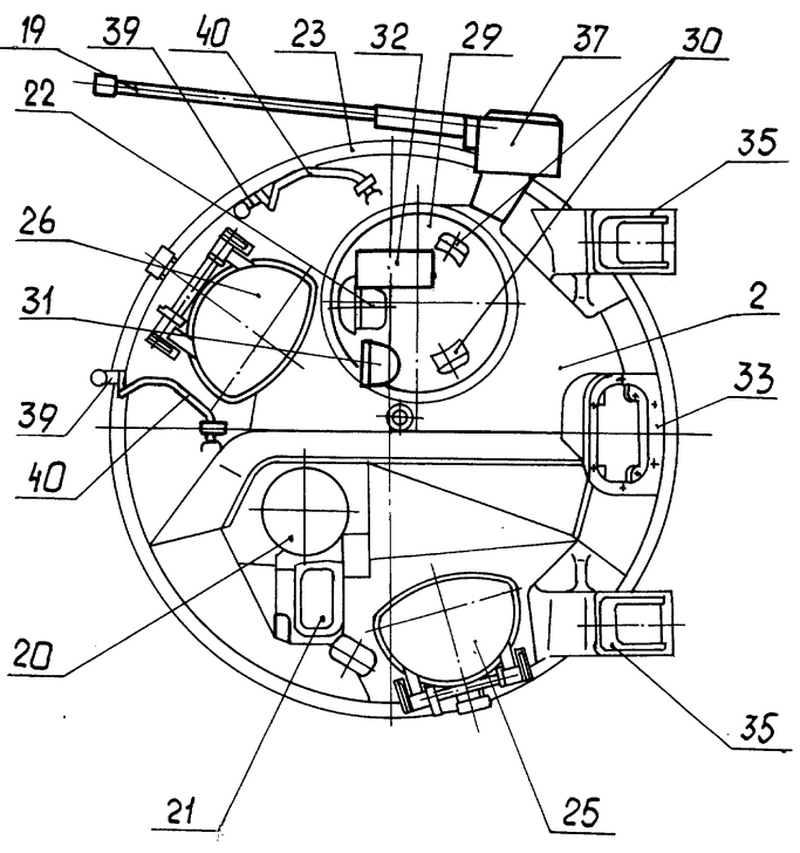
TOS-1M turret layout (patent)
The design introduced the following improvements to the TOS:
- Additional 30mm autocannon installed on the side of the turret below the launcher (in later iterations, this was removed due to the complications with its installation)
- Additional thermal imager
- Improved range from 3km to 5-7km
- Improved accuracy due to a modernized ballistic computer
- Improved rocket performance (the original Buratino’s one rocket covered 700 m2 with a whole salvo covering 1 to 1,5 hectare, improved to 900m2 and 2 hectares)
- Reduced height of the vehicle by reducing the launcher capacity from 30 to 24 rockets
- Added ability to fire without deploying the outriggers thanks to a new suspension—blocking system
- Upgraded chassis from the original T-72 platform to a “contemporary tank” with the T-80U being the most likely candidate due to the fact it was produced in Omsk
- Additional protection in the form of hard-kill APS
The design is described in detail in Patent No. 97107808/20 from 13.05.1997. The vehicle weighed some 44 tons and had a crew of three men (driver, commander and weapon operator). The hull protection was taken from the basic MBT model the TOS is built on (our model uses the T-90 MBT as a basis) while the launcher could resist small arms only (in reality, firing at the launcher results in a rather spectacular explosion, something the TOS-1M was designed to avoid). Additional protection was provided by:
- 902G Tucha smoke grenade launcher system
- Argus-KSIZ soft-kill APS
- T2A2 hard-kill APS
The firepower consisted of 24 massive 220mm thermobaric rockets in a box-like launcher as well as one 30mm 2A42 autocannon mounted on the right side of the turret. The exact way how the weapon was supposed to be installed was not specified – we have come up with a modified helicopter mount that would fit the design.
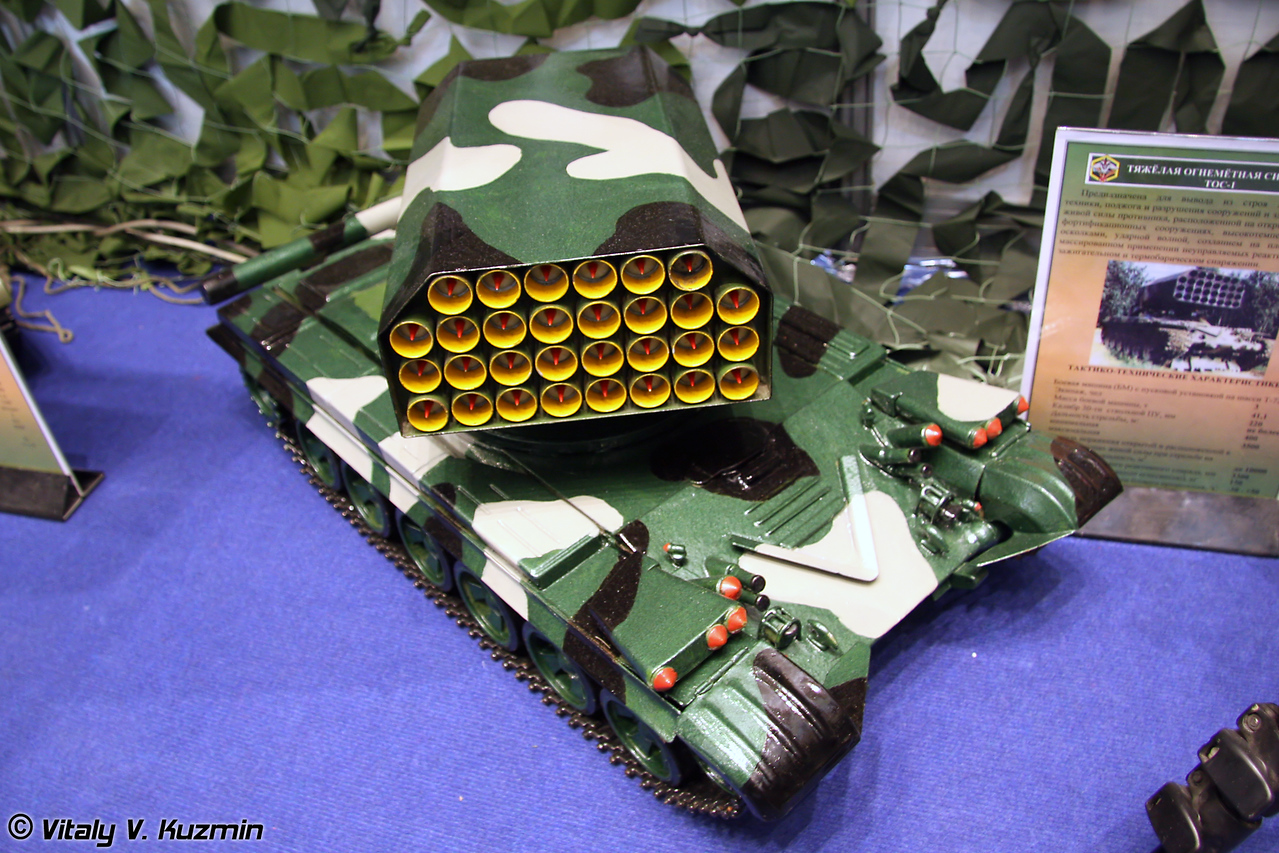
TOS-1 variant with hard-kill APS
The launcher and the cannon could depress to -3 degrees and elevate to +48 degrees. Two rocket types were used:
- MO.1.01.04M (thermobaric)
- MO.1.01.04M.OP (high-explosive incendiary)
The fire control system included:
- 1D14 rangefinder
- TKN-3 commander optics
- Ballistic computer set
An alternative weapons project was also envisaged. Instead of 24 220mm rockets, there was a version with 80 smaller 122mm rockets developed from the Grad MLRS rockets (but not identical). At least one prototype was built and trialed with unknown results. Little else is known about this variant.
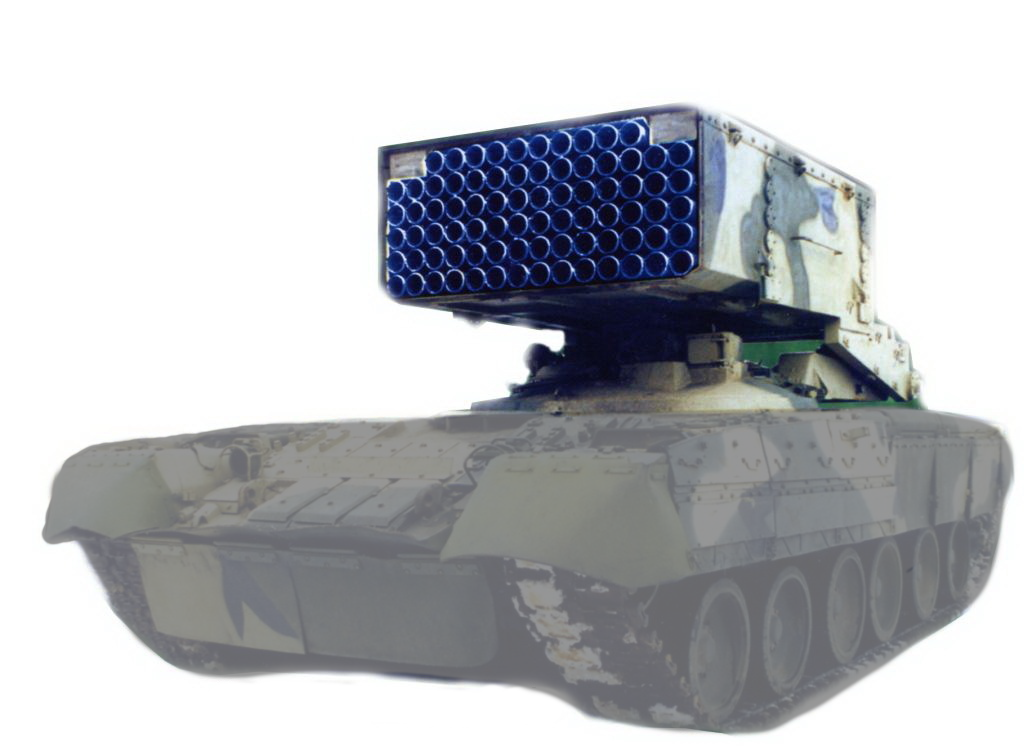
TOS-1 variant with T-80 hull, 122mm rockets
The vehicle was powered by the T-90’s V-84MS diesel producing 840hp. The maximum speed was 60 km/h – at least in “our” configuration (the T-80 variant would naturally have a gas turbine).
As you probably know by now, it wasn’t approved for further development. The most likely reason is that the T-80 series of MBTs fell out of favor after the infamous Battle of Grozny due to their poor performance and vulnerable ammunition. Anything T-80-related would therefore have a hard time getting funding.
Besides, the T-80 chassis was not strong enough on its own and would have to be modified significantly, which constituted another major expense. The T-72-based or T-90-based TOS-1A was developed and produced instead.
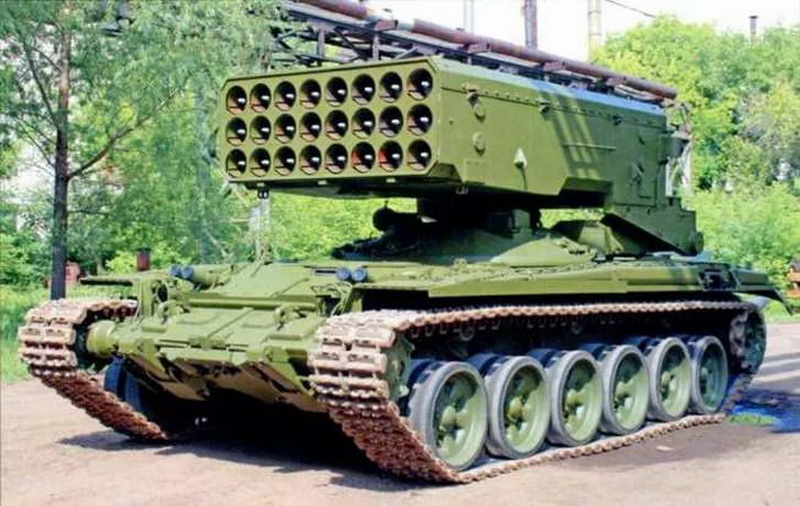
TOS-1 variant with T-90S hull
Russia itself has about 50 TOS-1A vehicles in service but it also became a fairly successful export item, no doubt thanks to its terrifying reputation:
- Kazakhstan bought 3 in 2013-2014, first shown in 2015 during a military parade (these are intended to work with the BMPTs – TOS-1A rockets hit the area and the Terminators mop up the rest)
- Azerbaijan also bought 18-36 in 2013-2014, these were T-90-based
- Iraq bought 12 vehicles in 2014
- Algeria bought 36 in 2017, first unveiled in 2018
- Syria and Tajikistan also have some according to certain sources and Saudi Arabia might be interested in license-production.
In total, the TOS-1A production seems to have reached approximately 160-200 vehicles between 2003 and this day. The exact number is unknown but according to some sources, the production is actually ongoing (for the Russian Army) next to its supposed replacement, the TOS-2 that is not tank-based but uses an Ural 6x6 truck as its platform of choice. As for the earlier Buratino, it’s unclear how many vehicles were built, possibly only the original two.
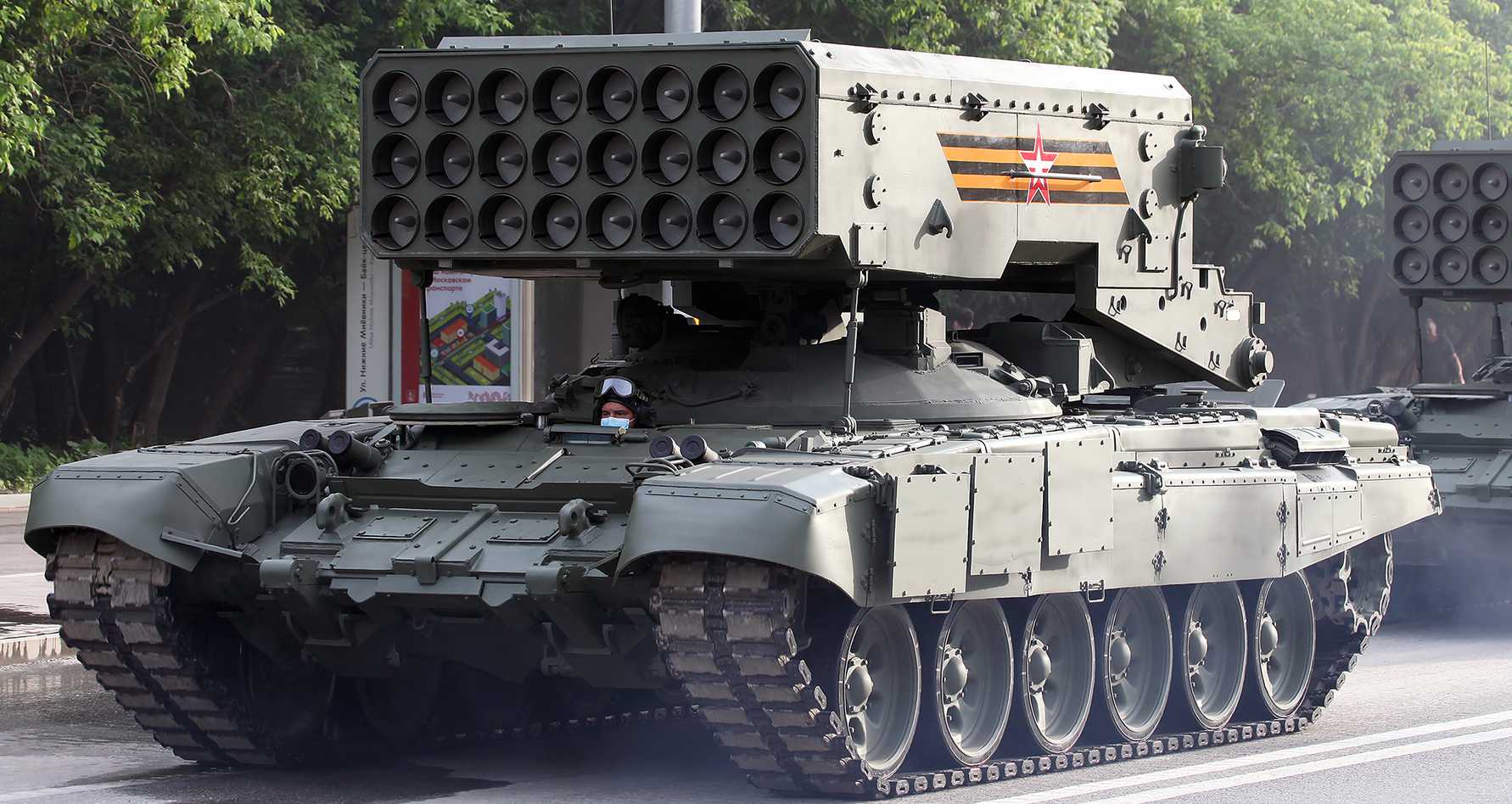
TOS-1A
As for their combat use – as stated above, the first operational use for the two prototypes took place between 1988 and 1989 in Afghanistan (some sources claim they were used as early as 1985). It took another decade before they saw combat again – the Second Chechen War highlighted their fearsome firepower. The Iraqis used the TOS successfully in 2014 during their war against the Islamic State. Between 2015 and 2018, the TOS was used in Syria as well and, last but not least, in the Azerbaijan and Armenia conflict in 2016 and 2020 – by the Azerbaijanis. Most recently, the TOS-1A appeared in Ukraine.
It’s worth noting that the weapon system is quite difficult to operate, to reload and is very rare. Due to its notoriety, many large explosions and rocket salvos were attributed to it by journalists but the reality is that most people can’t tell a thermobaric explosion from a normal one and most of the reported “TOS operations” were in fact performed by standard Grad reactive artillery. Nevertheless, wherever the TOS appears, destruction follows in its wake.
In Armored Warfare, the TOS-1M Buratino will be a Tier 10 Premium Tank Destroyer.
As this vehicle is fairly unique, you’re probably wondering how exactly this vehicle will work in the game. Here’s how.
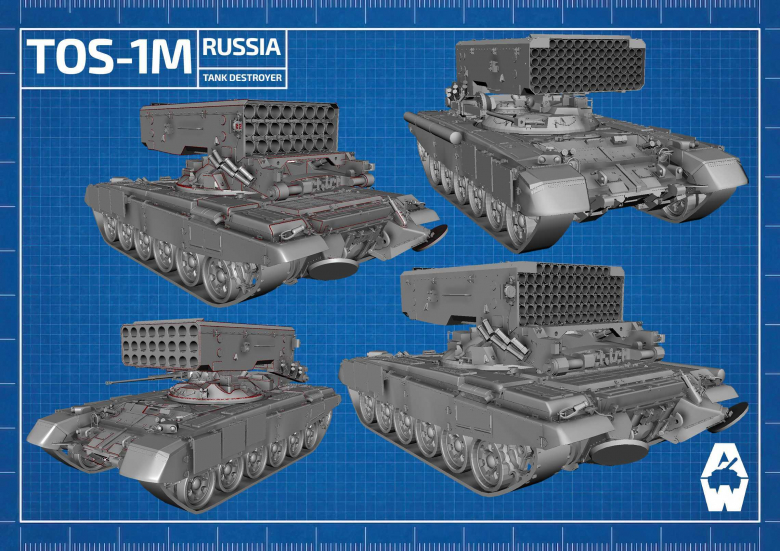
Click the image to open a larger version
As you might have guessed from the screenshots, the platform is T-90A-based. This is not something fictional – in 2011, the TOS-1A was modernized to use a T-90S chassis and the T-90S really is a T-90A predecessor. The T-90A uses Kontakt-5 armor and you’ll be glad to know those side panels will be working as intended (we’ll fix that for the basic T-90A as well but that is a topic for another time).
The chassis will have both soft-kill APS and hard-kill APS, but both inferior to the Malakhit system of Armata – this is also real part of the TOS-1M system.
The launcher will be treated as an unmanned turret and will have enough armor to protect it against 30mm autocannons. We’ll be using a solution from SBS Pindad where the vehicle does technically not have an ammo rack module as firing at the launcher would obviously immediately set off an explosion, which would be realistic but not very fun to play.
There will be two firepower configurations and both will play very differently.
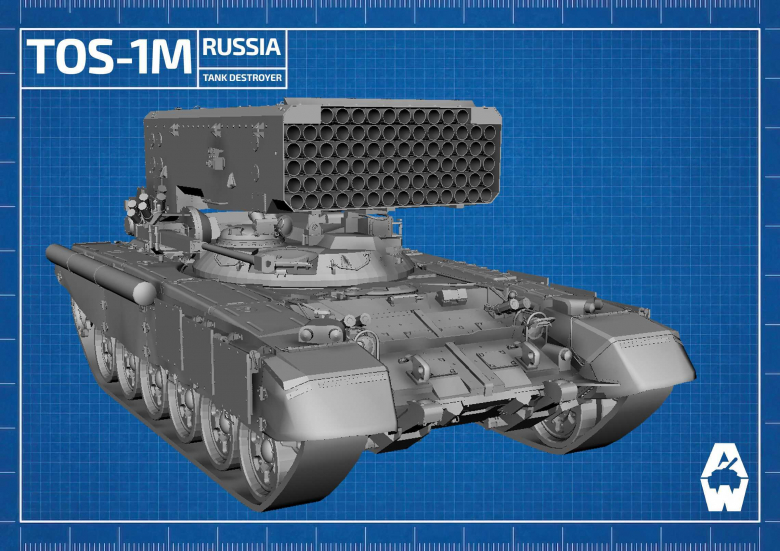
Click the image to open a larger version
The stock configuration uses 122mm rockets and is based on the photo of the TOS prototype. This configuration will essentially play like a Tier 10 version of the Tier 6 MT-LB S8 AFV, a favorite vehicle of many players. In real-life, the TOS is rather inaccurate and short-ranged and we’ll be implementing its essence to work exactly like that. The rockets will behave roughly like the ones on the MT-LB S8 – high-explosive warheads, not very accurate at long ranges but excellent at short ones. The rockets will fly directly towards the target, also just like on the MT-LB S8. You’ll have 80 of those in your launcher and 160 in total. However, there will be no partial reload and once your launcher is empty, you’ll have to suffer a very long time before the whole launcher is reloaded again.
During that time, you’ll have to make do with your backup weapon, which is the 30mm 2A42 autocannon. This weapon will work almost exactly like the one of the Object 195 MBT does – a limited rate of fire with 40-round clip of basic APDS and HE ammunition. This weapon will be useful against lighter targets but its limited performance will not allow you to effectively engage heavier enemies.
Both the launcher and the autocannon will feature very limited gun depression (-3 degrees), which will make it even more difficult to use the autocannon effectively. You’ll have to position yourself carefully instead of rushing your enemies.
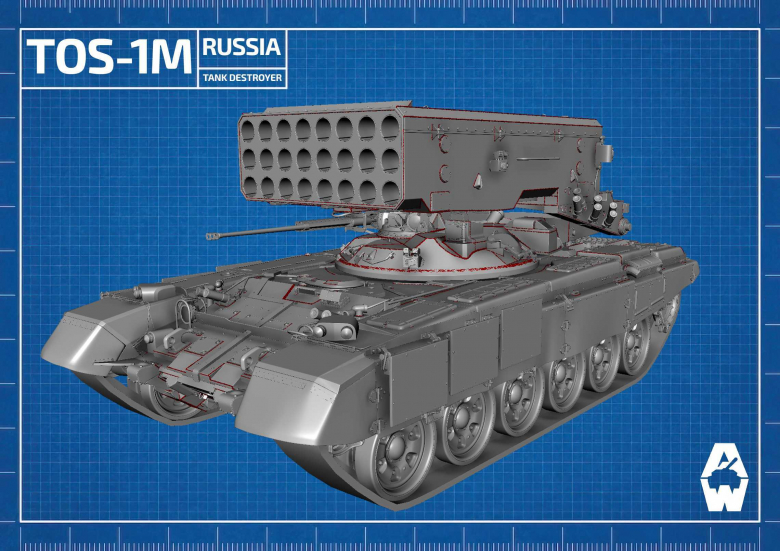
Click the image to open a larger version
And then there’s the upgraded configuration with 220mm rockets. Yes, that’s a thing. You’ll be able to unlock this configuration with basic 220mm thermobaric rockets by completing Battle Path missions and tasks (via the Battle Path Workshop). As you can imagine, an impact of a 220mm rocket that’s longer than a tank barrel is absolutely devastating and, indeed, these will offer the highest damage per shot (alpha) in the game as well as decent penetration. How much exactly – that’s something we need to tweak, but getting hit by one of these will hurt a lot. You’ll have 24 of these (one “magazine”) and you’ll be able to launch one every 10 seconds or so.
Additionally, you’ll be able to unlock (via the Battle Path Workshop) even more powerful thermobaric 220mm rockets that trade the ability to cause damage by direct hits (by having reduced penetration) for more splash damage.
Sounds insane? Not quite as there will be numerous drawbacks to the 220mm configuration.
- Trajectory – unlike the 122mm configuration the 220mm configuration uses Pindad’s high arc of flight
- Flight velocity – the 220mm rockets will have a very low velocity, making them easier to avoid especially at longer distances
- Low penetration – the 220mm rockets will not penetrate thick armor and most damage they will cause will be reduced
- Skills increasing the amount of ammunition carried will not work here as using it will trigger a reload of several minutes, effectively disabling the launcher until the end of combat
In other words, a hit by one of these will deal monstrous damage – but you’ll have to earn it.
As for the rest, well... do you truly care about the rest? No active abilities, no camouflage (a box firing telephone pole-sized rockets into the sky tends to be conspicuous) and the vehicle will be blind as a bat. The mobility will resemble the original T-90A tank, perhaps a bit slower. And that’s about it. Despite these disadvantages, we hope – no, we KNOW – you’ll have a lot of fun with it just like you are with the AVRE. Because this is the TOS – it hardly gets any more awesome than that.
We’ll see you on the battlefield!




